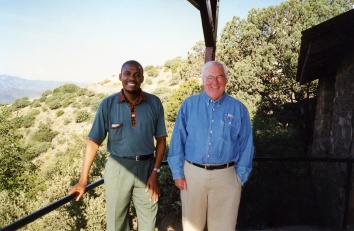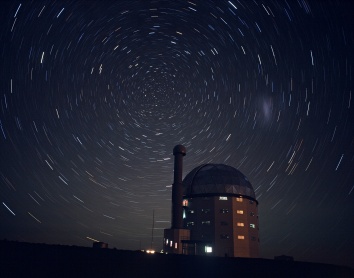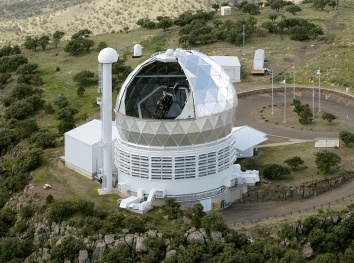University of Texas at Austin helped build giant African telescope
9 November 2005
Texas and South Africa to reap scientific and economic benefits
SUTHERLAND, SOUTH AFRICA — Tomorrow, a global group of partners will inaugurate the newly completed 11-meter Southern African Large Telescope (SALT), the largest telescope in the southern hemisphere and, like the Hobby-Eberly Telescope (HET) in Texas, one of the world's largest.
Just over nine years ago, Frank Bash, then director of The University of Texas at Austin McDonald Observatory, traveled to Pretoria, South Africa to visit Khotso Mokhele, president of South Africa's National Research Foundation. Together with Penn State's Larry Ramsey, project scientist for the HET at McDonald, Bash suggested that South Africa build a copy of the HET.
A contingent of about three dozen Texans will travel to Africa for the inauguration, including the university's Vice President for Research Juan Sanchez, Vice Provost Lucia Gilbert and McDonald Observatory Director David Lambert. The rest of the group comprises University of Texas at Austin astronomers and about 20 members of McDonald's Board of Visitors. Former Texas Lieutenant Governor William P. Hobby, namesake of the HET, will attend the event, along with his wife.
After Bash and Ramsey's 1996 African trip, “the seed started to sprout,” Bash says. The South African parliament approved the project and committed half of its funding on condition that they find partners to supply the other half.
“We helped them find partners, and formed a board of directors for SALT,” Bash says. The prospective members joined the board, which met at different locations around the world over several years, including Poland and New Zealand.
Tom Sebring was the project manager for construction of HET. He and Bash traveled to South Africa to choose a project manager for SALT's construction. At the time, Bash recalls, Sebring pointed out that, as a national project, SALT could involve the nation's schools and engineering students.
“So 'collateral benefits' workshops were held,” Bash says. Engineering fellowships were created. “South African industry got really involved, and it became a point of pride for South Africa to do as much of it as they could. They did an amazing job.”
Regarding the construction of the telescope itself, “we helped them avoid some of the pitfalls” we encountered in building HET, Bash said. “I don't think there's any doubt that SALT is an improvement on HET as a result.”
Mokhele visited McDonald Observatory in summer 2000 to speak about SALT to a gathering of McDonald's Board of Visitors.
“Maybe it sounds fantastic for South Africa to want to play in the big leagues of astronomy,” he said. “Does it not have more pressing needs, more pressing problems that it should tackle now and maybe contemplate astronomy sometime else? But unless we start to make the sorts of investments that SALT is, then we never come out of poverty.
“I want to assure you that to us [SALT] has always been and will always be something bigger than just a fancy and expensive toy for a few astronomers with foreign accents to come to South Africa to play around with. It is a project that sits in the gut of our national development agenda. It's a project that sits in the gut of our desire and determination to change the fortunes of South Africa as a country, to change education in mathematics and science, to change the attitudes and confidences of math and science teachers.”
Bash wants Texans to know the role they played in bringing about this project half a world away.
“Texans ought to be proud that it probably wouldn't have happened had we not planted the seed,” he says. “We supported it all along, giving advice and sending plans.”
The HET board contributed the engineering plans for HET, as well as countless hours of time and expertise, though no cash.
“As a result of our contribution, the five-member HET partnership has 10 percent of the observing time on SALT,” Bash says. That computes to six percent for University of Texas at Austin astronomers, or 21 nights per year.
According to McDonald director Lambert, this access to SALT will provide Texas astronomers a window on the southern hemisphere, where they can study skies not accessible from North America. Objects of particular note include the center of the Milky Way galaxy, as well as the two nearest galaxies, the Large and Small Magellanic Clouds.
And, he says, SALT is “a beautiful vindication of the effort we put into HET, that the South Africans chose to build a copy of it.”
Preceding the Nov. 10 inauguration events, a symposium on African astronomical history will be held in Cape Town on Nov. 8 and 9. After the SALT inauguration, the International Astronomical Union and the International Union of Pure and Applied Physics will hold a week-long symposium called “The Case for Extremely Large Telescopes” in Sutherland.
The Hobby-Eberly Telescope is a joint project of The University of Texas at Austin, The Pennsylvania State University (Penn State), Stanford University, Ludwig-Maximilians-Universität München, and Georg-August-Unversität Göttingen.
— END —
Notes
SALT partners in South Africa include:
- The South African Astronomical Observatory
- The Department of Arts, Culture, Science and Technology
- The National Research Foundation
International partners include:
- The Hobby-Eberly Telescope Board (comprising The University of Texas at Austin, The Pennsylvania State University, Stanford University, Georg-August-Universität Göttingen, and Ludwig Maximilians Universität Munchen)
- Rutgers, the State University of New Jersey
- The University of Wisconsin - Madison
- University of North Carolina - Chapel Hill
- Dartmouth College
- Carnegie Mellon University
- University of Canterbury (New Zealand)
- Nicolaus Copernicus Astronomical Centre of the Polish Academy of Sciences (Poland)
- Georg-August-Universität Göttingen (Germany)
- The United Kingdom SALT Consortium (comprising the Armagh Observatory, the University of Keele, the University of Central Lancashire, the University of Nottingham, the Open University, and the University of Southampton)








